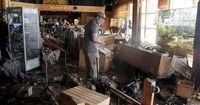In the wake of a summer marked by relentless storms and catastrophic flooding across the Midwest, federal disaster aid is finally flowing to battered communities in Wisconsin and North Dakota. President Donald Trump’s recent approval of disaster declarations has brought a measure of relief to thousands of residents whose homes, businesses, and public infrastructure were devastated by the extreme weather events of June through August 2025. Yet, the process has not been without controversy, delays, and lingering questions about the adequacy and speed of federal response.
On September 11, 2025, President Trump announced on social media that he had approved $29.8 million in federal assistance for Wisconsin, specifically targeting residents in Milwaukee, Washington, and Waukesha counties—areas that bore the brunt of the August floods. According to WISN and the Associated Press, the flooding destroyed or severely damaged more than 1,500 homes, with private property losses estimated at $33 million and public sector damage topping $43 million across six counties. The Milwaukee County tally alone reached an estimated $52 million in damages.
For many Wisconsinites, the aid couldn’t come soon enough. As Governor Tony Evers wrote in his urgent August 27 letter to the president, "Families, kids, homes, and livelihoods have been significantly impacted, and the damage caused by historic storms and flooding has gone beyond the capacity of state and local resources to manage." Evers further emphasized the dire situation, noting, "Many survivors are living in severely damaged homes without furnaces or water heaters. I therefore respectfully request that you review this documentation and act quickly."
Despite the urgency, the approval process was not swift. The Associated Press reported that, except for Wisconsin, it took Trump more than a month to approve aid requests from affected states and tribes—a pattern that reflects a broader trend of growing delays in disaster relief approvals, regardless of which party holds the White House. The AP’s analysis found that while it took less than two weeks on average for disaster declarations to be granted in the 1990s and early 2000s, that interval has stretched to about three weeks in the past decade. During Trump’s first term, the average wait was 24 days; his most recent batch of approvals ranged from 15 days for Wisconsin to 56 days for a tribal request in Montana.
White House spokeswoman Abigail Jackson defended the approach, telling the AP that Trump is providing “a more thorough review of disaster declaration requests than any Administration has before him” to ensure that federal tax dollars are spent wisely. But for storm survivors, these delays often translate into longer waits for daily living expenses, temporary lodging, and critical home repairs. Local officials, meanwhile, are left uncertain about reimbursement for debris removal and infrastructure rebuilding, potentially slowing recovery efforts on the ground.
In Wisconsin, Governor Evers expressed gratitude to the volunteers and organizations assisting in recovery but made it clear that the state’s needs remain unmet. "I will continue to urge the Trump Administration to approve the remainder of my request, and I will keep fighting to make sure Wisconsin receives every resource that is needed and available," Evers stated in a press release following Trump’s announcement. Notably, the president’s approval covered only three of the six counties Evers had requested aid for, leaving some communities still waiting for federal support.
For affected residents, the process of applying for assistance is now underway. FEMA aid is officially available, and those impacted can submit their claims through DisasterAssistance.gov, by calling 800-621-3362, or by visiting Disaster Recovery Centers being set up in the hardest-hit areas. Applicants are required to provide contact information, Social Security numbers, photos of damage, receipts, insurance policy details, and documentation of claims related to the flooding. There’s a cap of $43,600 per household for housing assistance, which covers repairs to make primary residences safe and functional, rental assistance, and accessibility-related work for survivors with disabilities. Other eligible expenses include child care, medical and dental costs, funeral expenses, and transportation needs directly tied to the disaster.
Alex Freeman of the Waukesha County Office of Emergency Management told WISN, “They’re going to want things like photos of their damage, any receipts or invoices related to their damage, as well as insurance policy information and any claims that they made related to their flooding impacts.” He added that the financial assistance “is really going to make a difference. The difference many have been anxiously awaiting.”
While the aid is a lifeline for many, some residents worry it won’t be enough. As one flood victim put it, “It’s well over what my insurance is going to cover. I definitely fell off some paperwork or whatever you got to do to, you know, get a little help, but that’ll help.”
Meanwhile, North Dakota and several other states also received federal disaster declarations following storms in June and July. On September 14, President Trump approved relief for 19 North Dakota counties hit by tornadoes, hail, and straight-line winds on June 20-21, unlocking federal funds for public infrastructure and recovery. Governor Kelly Armstrong, who requested aid after a preliminary damage assessment exceeded $11.4 million, praised the decision, stating, “This much-needed disaster aid will help our state’s communities and utilities recover from one of the most powerful summer storms in recent history.”
Trump’s latest batch of disaster declarations also included Kansas, North Carolina, and tribes in Montana and South Dakota, reflecting the widespread impact of severe weather across the country. However, the president has not approved requests for hazard mitigation assistance—funds that help communities rebuild with resilience—since February, diverging from past federal disaster responses.
Amid the scramble for aid, the Federal Emergency Management Agency (FEMA) itself has come under scrutiny. In August, nearly 200 FEMA employees signed an open letter, dubbed the "Katrina Declaration," warning that recent policy changes at the agency could endanger future emergency response efforts and put American lives at risk. Several signatories were reportedly suspended after the letter’s release, raising concerns about the agency’s internal culture and readiness.
As the climate crisis intensifies, storms like those that battered Wisconsin and North Dakota are expected to become more frequent and severe. State and local officials, as well as storm survivors, are left hoping that federal aid—however delayed or partial—will help them rebuild and prepare for whatever comes next. For now, the road to recovery is long, but with applications open and assistance flowing, communities are taking their first steps back toward normalcy.





